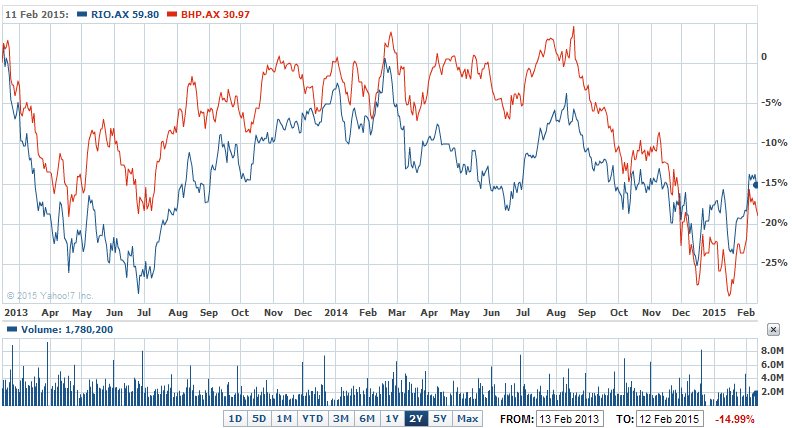Talk about conflicting messages. One the one hand Rio Tinto (RIO) has warned of further price pressures for mining, on the other it handed out the goodies to shareholders.
As expected, Rio revealed plans to give shareholders a buyback and a higher dividend, despite reporting its equal lowest underlying profit in five years.
The promise to reward shareholders was reaffirmed last year when Glencore, the acquisitive commodities trading and investment group, tried to buy Rio in a merger of equals.
Significant falls in the price of iron ore and copper through 2014 ensured the miner‘s underlying profit of $US9.3 billion was 10% lower than the $US10.2 billion achieved in 2013.
That was driven by an 18% fall in earnings from the company’s huge West Australian iron ore operations.
The underlying profit was higher than market forecasts, as Rio slashed spending on capex and costs, but shareholders were most focused on the extra shareholder returns that chief executive Sam Walsh had promised, and unveiled yesterday.
Shareholders will get a final dividend of $US1.19 a share (around $A1.55 at 77 US cents to the dollar). That took the total for 2014 to $US2.15.
The miner will also spend $US2 billion on buying back its own shares, the first major share buyback since 2011.
Rio warned that the mining sector faced further problems in 2015, especially from the slowing Chinese economy, and continuing pressure on margins.
While Chinese growth drove demand for most commodities over the past decade mining was now having to adjust to a new phase of economic development in China that was "likely to result in lower price levels compared with those seen during China’s years of capital intensive growth", Rio said last night.
However, the miner said it believed that margins for low-cost producers should remain higher than the average levels of a decade ago (naturally Rio includes itself in this group).
Rio has been under pressure to raise returns to shareholders who have been unhappy that too great a proportion of profits was recycled into expansion during the commodities boom.
The buyback in 2011 wasn’t enough. Complicating the matter for Rio was some silly investment decisions by previous management, such as the $US4 billion purchase of a coal mine in Mozambique which had to be written off – that cost the company its CEO and chief financial officer, plus changes on the board.
The latest buyback is seen as a way to reassuring investors, especially after Rio rebuffed the informal approach last year from Glencore.
RIO vs BHP 2Y – Rio rewards shareholders despite profit slide

CEO, Sam Walsh said yesterday: "Last year, we made a clear commitment to materially increase cash returns to our shareholders. Decisive early action throughout the group delivered the strong balance sheet, which enables us to announce today’s additional material cash return."
Rio flagged the buyback last year after it said it was happy with its debt levels. By year-end net debt had been cut from $US18.1 billion to $US12.5 billion. Capital spending was slashed 37% to $8.7 billion, with a further cut to around $US7 billion a year over the next couple of year.
Although Glencore has to wait until April before being able to renew its approaches to Rio, the plunge in commodity prices and weakening financial position at Glencore, makes a renewed assault on Rio highly unlikely.
In fact Glencore has been warned its credit rating could be lowered closer to junk levels if commodity prices fall further and it takes on more debt. On Wednesday Glencore revealed plans to cut spending across the board and freeze hiring at its mining operations (mostly acquired in the Xstrata takeover).
The miner’s final profit was $US6.5 billion, higher than $US3.66 billion in 2013, which was cut by big write downs on aluminium and on that mine in Mozambique.
Rio’s Australian shares closed 10 cents higher at $59.90 yesterday before the results were released.
On a divisional basis, aluminium was the big improver, climbing above the copper division to be the second-biggest contributor to Rio’s bottom line, both on an EBITDA and an underlying earnings basis, where it delivered $US1.4 billion to the company’s coffers.
Improving aluminium and bauxite prices over the last half of 2014 also prompted Rio to "write back" more than $US1 billion of book value for the division, which has been the subject of almost $US30 billion of write-downs since the silly Alcan takeover in 2007.
Despite the fall in iron ore prices, the iron ore division remained easily Rio’s biggest money spinner, delivering $US8.1 billion of underlying earnings.
Speaking after the result’s release, Mr Walsh made it clear that weak iron ore prices would not cause Rio to halt its iron ore expansion in Western Australia, saying the division would continue to increase exports.













